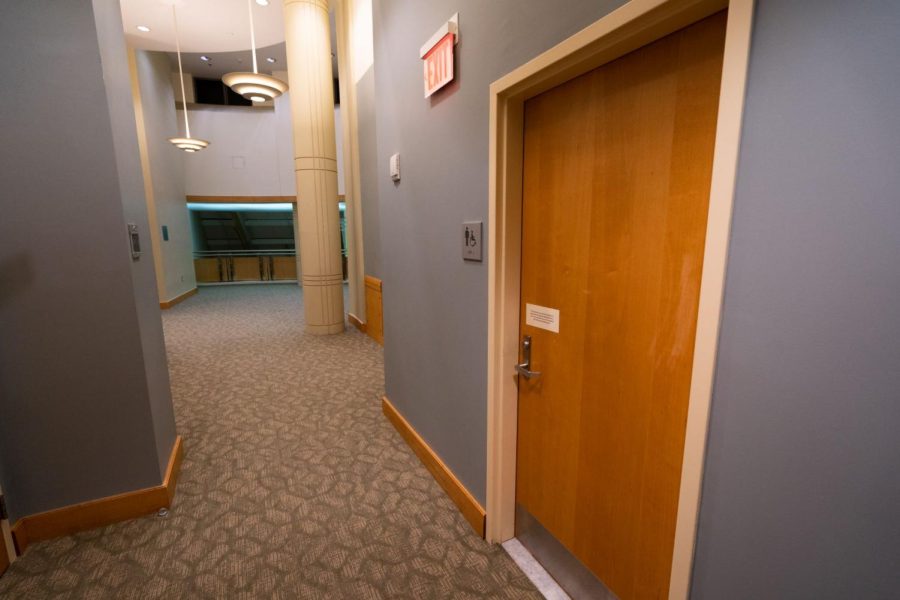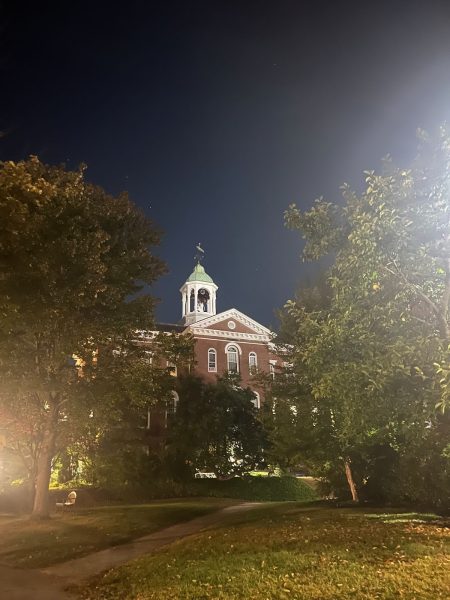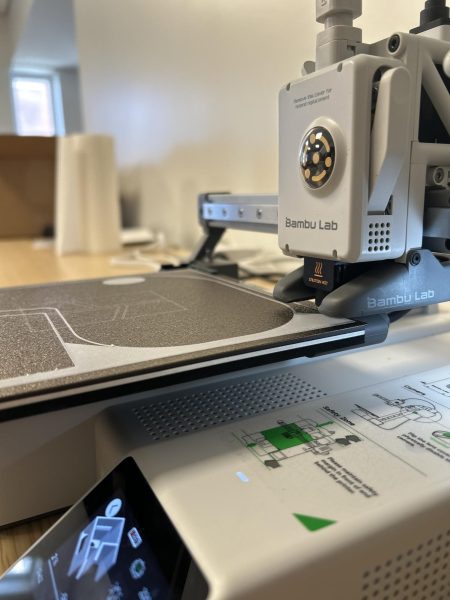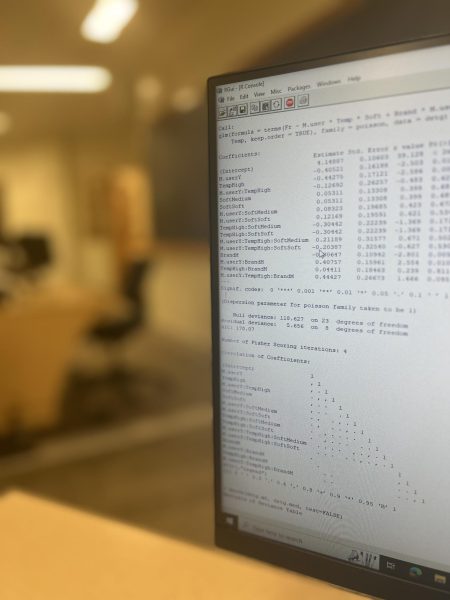Amid Lack of Gender Neutral Spaces, Bates Students Mobilize for Bathroom Equity
On Oct. 24, Bates students met at the Multifaith Chaplaincy to discuss steps that could be taken to ensure that accessible and gender neutral bathrooms would be widely provided on campus. There is only one academic building on campus that doesn’t have a single-occupancy, gender neutral restroom: Pettengill Hall. Disabled students have not been provided with the facilities necessary to feel comfortable, too.
This event was public, but many have been fighting for bathroom equity for years in more individual ways. Around 20 Bates students and a handful of faculty and staff attended the event, which was facilitated by two Multifaith Fellows. One of the fellows, Tyler Shambaugh (he/they) ‘23, described how students were mobilizing after the lack of success faced by the Bathroom Equity Committee that was established last year. Difficulty securing funding and complex plumbing codes were cited as the primary issues that were previously faced.
One of the main topics of discussion was how there are both long term and short term goals when it comes to securing bathroom equity. While the construction of new facilities might take longer to accomplish, changes can be made in Residence Life to make students feel more comfortable with the restrooms on campus.
Students also discussed how some believe that creating gender neutral bathrooms will create spaces for sexual assault and violence to take place. However, this is not an issue of bathrooms, but rather of people who feel comfortable committing such crimes. The Aunt Flow project has started to break down gender barriers in bathrooms across campus.
Weeks later, The Bates Student met with Shambaugh and Mason Bunker (he/they) ‘23 to discuss the actions being taken to ensure bathroom equity.
“All of this kind of started because Tyler Shambaugh wanted to write a transgender resource guide,” Bunker explained. “And in creating that, a large conversation was bathrooms.” One of the first steps that the two took was to visit each bathroom on campus to confirm single user restrooms were labeled as gender neutral. They were also tasked with determining whether or not it was truly accessible. They did note that they were generally unqualified to make these official determinations.
Bunker expressed a degree of frustration with the Bates administration. He attempted to advocate for changes during his first year at Bates, but while the administration acknowledged the issues surrounding a lack of equity, no official measures were taken. Frustration was also expressed regarding the lack of accessibility training given to Residence Life staff as they work with students.
One student signed up for the president’s office hours and had the chance to speak to President Spencer in spring of 2020. The student noted that the meeting was productive, but no action was taken in the following months. The inability for students to use bathroom facilities that they feel safe in can lead to mental and physical dangers, they said.
According to Shambaugh and Bunker, Pettengill Hall is a building that has posed issues for a number of students, as it is one of the largest classroom spaces on campus. It is home to most departments—including Gender and Sexuality Studies—and almost every student takes a class there throughout their Bates careers. Every other academic building on campus has a gender neutral bathroom.
In 2019, the official Bates College All Gender Restroom list included a single stall bathroom on the first floor of Pettengill, but it is only accessible through the women’s room. There are single stall bathrooms on the fourth floor of the building; however, they are officially gendered. In the state of Maine, public single stall bathrooms cannot legally be gendered; but, these bathrooms are locked for most of the year. They are only unlocked during meetings for the Board of Trustees, which from records appears to only meet once a season (fall, winter and spring).
It is believed by a number of students that by locking these facilities, the college has no legal responsibility to remove the gendered signs outside the bathrooms. Shambaugh noted, “We don’t need to start with every floor, we don’t need every floor to be gender neutral. But we need gender neutral bathrooms in PGill.”
There is also a lack of fully accessible restrooms in athletic facilities. Bunker said: “The best that you can get is like PGill: there is a single-user restroom that you can use that is attached to [the gendered restrooms].”
The Student reached out to the Bates College administration for a comment on gender neutral bathrooms and ADA accessible bathrooms. The following statement came from Mary Pols, a college spokesperson, “Multiple departments at Bates, including Facility Services, Residence Life and Health Education, and our Title IX Team are engaged in conversations about ways to meet growing community needs for accessible and gender-neutral bathrooms.”
She added that “every campus construction project, whether a renovation or a new building, includes discussion and planning about the best ways to make all feel comfortable and welcome in campus bathrooms. Results from these efforts can be seen in many buildings on campus, including Bonney, Dana, and others. Current building conditions and codes limit actions the college can take in existing buildings, including residence halls, without major renovations but we are actively looking for creative approaches that can help us meet these needs.”
Pols added that the Office of Intercultural Education (OIE) maintains a full list of all-gender bathrooms on campus, and shared a list of the spaces with The Student:
- “In Bonney Science Center we have gender-neutral, ADA accessible bathrooms.
- Renovations in Dana involved a comprehensive re-set of the bathroom facilities to make them more accessible in every way.
- Commons, Hedge, Roger Williams, Chu and Kalperis all have included accessible, gender-neutral, single-user restrooms.
- Hathorn now has two accessible, gender-neutral, single-user restrooms.
- At Chase, after the renovation is complete, the building will include multiple accessible, gender-neutral, single use restrooms.
- Adjacent to Memorial Commons and the OIE, we are adding new ADA compliant multi-user restrooms.
- At Ladd, signage outside multi-user restrooms lets individuals know they may use the facility they associate with. This approach is one we are reviewing for other areas of the campus.”
Both Shambaugh and Bunker suggested that while people are open to creating more gender-neutral bathrooms, as evidenced by the college’s statement, unfortunately, there is no official protocol for removing signage or alerting students of official changes. Right now, one of their goals is to find a staff member or administrator who might be able to lead these changes.
They both mentioned how helpful the OIE Team and the Multifaith Chaplaincy have been throughout this process, particularly Dri Huber. Students at Bates are hoping to make serious headway this year. Shambaugh said this is particularly important in dorms: “Dorms are the one place where every single person really needs to use a bathroom. That’s where they shower and you want to make sure that every single person has a place where they feel comfortable.”
Your donation will support the student journalists of Bates College and help us cover our annual website hosting costs.

Fiona is a senior from Windham, Vermont. She has been writing for The Bates Student since her first semester on campus. Her majors are French & Francophone...







